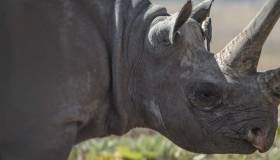DENVER/March 17, 2017 – Endangered San Joaquin kit foxes face many threats to their survival, including loss of habitat and competition with non-native species such as the red fox. Now, scientists are rushing to save remaining fragile populations from a new danger – sarcoptic mange, a skin disease caused by mites.
A recent publication by Morris Animal Foundation-funded researchers sheds light on the dynamics of this highly contagious disease, and gives desperately needed information to those working to save the San Joaquin kit fox, a subspecies of the smallest canid in North America. The paper was published in the January 2017 Journal of Wildlife Diseases.
The San Joaquin kit fox (Vulpes macrotis mutica) is endemic to central California’s San Joaquin Valley, but development of the area over the last century has led to a sharp decline in its population. Currently, there are fewer than 7,000 San Joaquin kit foxes, according to the California Department of Fish and Wildlife. A critical population located in the city of Bakersfield is threatened by sarcoptic mange, first identified in spring of 2013.
Sarcoptic mange is a highly contagious, zoonotic disease caused by Sarcoptes scabiei, a mite that burrows into the skin. Hair loss and skin lesions, compounded by intense itching and self-trauma, can be fatal in severe cases. Urgent management strategies are needed to stop transmission of the disease to other members of this unique population, as well as to to other kit fox groups and other canids, both wild and domestic.
“The research results presented in this paper established a critical foundation for understanding the epidemiology of sarcoptic mange and its impacts on an extremely important population of endangered San Joaquin kit foxes,” said Dr. Brian Cyphers, Associate Director and Research Ecologist of the Endangered Species Recovery Program at California State University, Stanislaus, and one of the paper’s authors.
During the study, the research team confirmed the diagnosis of sarcoptic mange in 15 kit foxes either captured or found deceased. The team successfully treated three animals of nine found alive. They found no evidence that untreated kit foxes can recover from the infection, meaning prevention and treatment are critical to containing the spread of the disease.
“With this foundational study, we have been able to leverage additional funding to continue our research, including identifying potential strategies to eliminate the disease from portions of this kit fox population and possibly from the entire population,” said Dr. Cyphers.
About Morris Animal Foundation
Morris Animal Foundation is a global leader in funding scientific studies that advance the health of companion animals, horses and wildlife. Since its founding in 1948, the Foundation has invested over $113 million in more than 2,500 studies that have led to significant breakthroughs in the diagnosis, treatment and prevention of diseases to benefit animals worldwide. To learn more, or to make a donation in support of life-saving research, visit Morris Animal Foundation.




